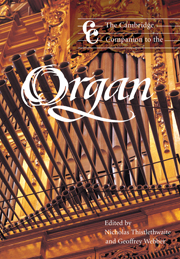Book contents
- Frontmatter
- Part I The instrument
- Part II The player
- Part III Selected repertoires
- 10 Italian organ music to Frescobaldi
- 11 Iberian organ music before 1700
- 12 The French classical organ school
- 13 English organ music to c1700
- 14 Catholic Germany and Austria 1648–c1800
- 15 The north German organ school
- 16 The organ music of J. S. Bach
- 17 German organ music after 1800
- 18 French and Belgian organ music after 1800
- 19 British organ music after 1800
- 20 North American organ music after 1800
- Appendix: The modes (toni) and their attributes according to Zarlino
- Notes
- Bibliography
- Index
18 - French and Belgian organ music after 1800
from Part III - Selected repertoires
Published online by Cambridge University Press: 28 September 2011
- Frontmatter
- Part I The instrument
- Part II The player
- Part III Selected repertoires
- 10 Italian organ music to Frescobaldi
- 11 Iberian organ music before 1700
- 12 The French classical organ school
- 13 English organ music to c1700
- 14 Catholic Germany and Austria 1648–c1800
- 15 The north German organ school
- 16 The organ music of J. S. Bach
- 17 German organ music after 1800
- 18 French and Belgian organ music after 1800
- 19 British organ music after 1800
- 20 North American organ music after 1800
- Appendix: The modes (toni) and their attributes according to Zarlino
- Notes
- Bibliography
- Index
Summary
The symphonic tradition in French organ music that was to find its first real expression in the works of César Franck had its roots in the period that followed the French Revolution of 1789.
This so-called ‘post-classical’ era has often been criticised as a time when musical quality fell sharply after the glories of the ‘Grand Siècle’, but there were important cultural reasons for the changes in public taste that many organists felt obliged to follow. Furthermore, one must distinguish between the music that composers published (often very light in character) and their reputations as performers and improvisers.
The ‘Terror’ that followed the revolution, when thousands were executed or arrested as ‘enemies of the Revolution’ also marked the secularisation of the Church: her assets were seized and services abolished, leaving organists (and organ builders) without a livelihood. The churches themselves were used as storerooms, barracks or stables and many organs were sold or destroyed. Stories abound of organists trying to save their instruments by playing patriotic songs, thus following a musical trend that was to reflect the political and military mood of the time. The foundation of the Conservatoire in 1795 and the increasing interest in opera heralded a musical liberation that would mark a decline in solemn church music. Napoleon was not slow to appreciate the power of music as a propaganda tool, asking composers to write music that would glorify his armies: this was the era of ‘battle’ pieces that were by no means confined to the orchestra.
- Type
- Chapter
- Information
- The Cambridge Companion to the Organ , pp. 263 - 278Publisher: Cambridge University PressPrint publication year: 1999
- 1
- Cited by

